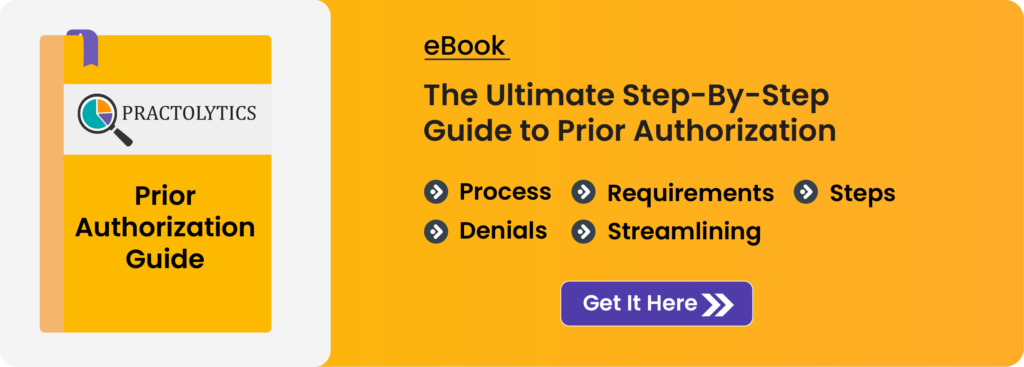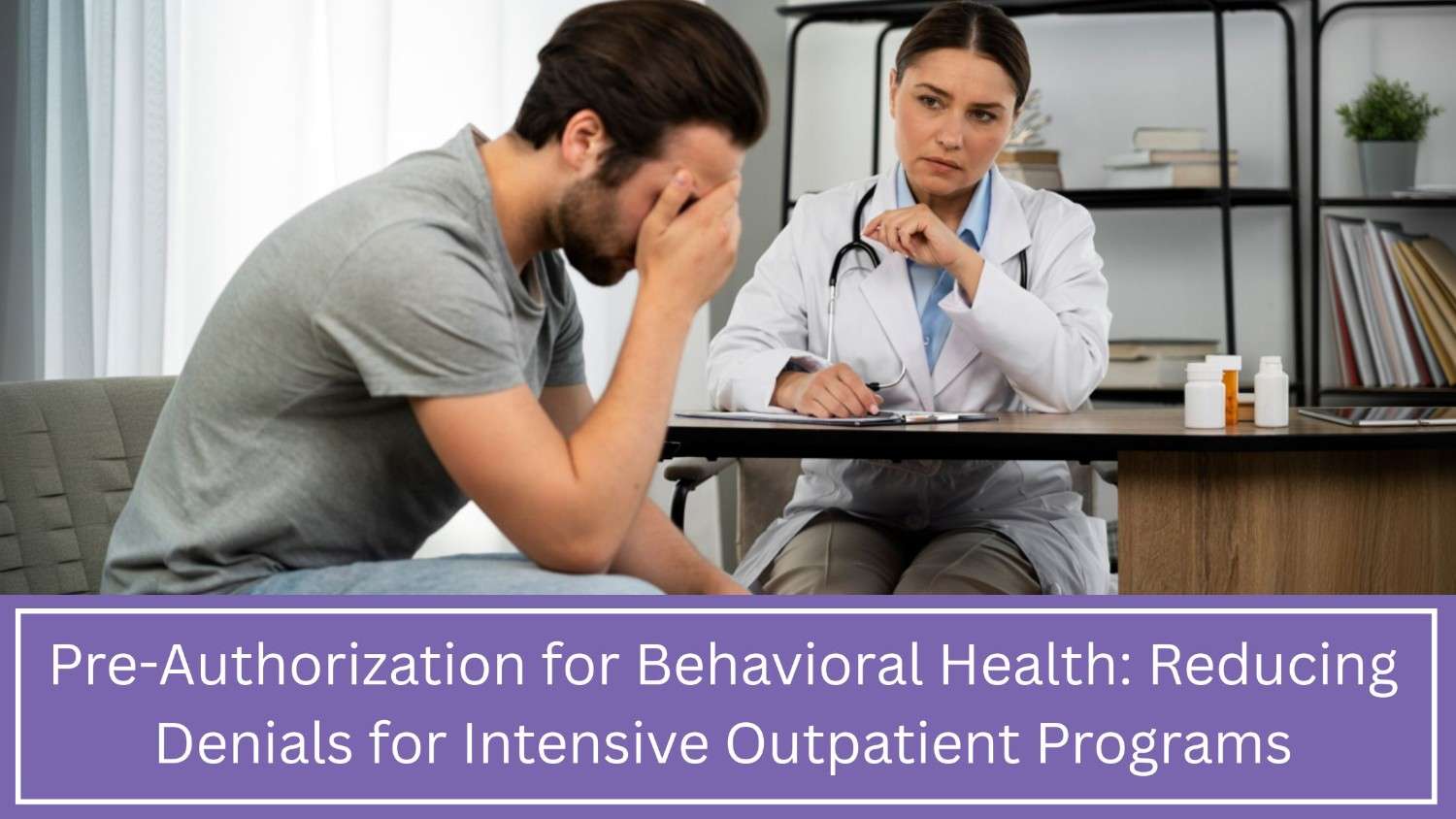5 Strategies to Simplify Prior Authorization in Mental Health Billing
At Practolytics, we understand the pressure providers face when managing 5 Strategies to Simplify Prior Authorization in Mental Health Billing and navigating payer rules. Mental health practices deal with complex documentation, unpredictable payer criteria, and slow response times. By combining automation, expert RCM support, and streamlined workflows, we help practices apply Best Practices for Mental Health Billing Prior Authorisation, improve their first-pass approval rate mental health prior authorisation, and simplify every step of the Prior auth process in mental health services. With our team, providers experience fewer delays, smoother automation prior authorization mental health billing workflow operations, and better financial outcomes.
Prior authorization in behavioral health has always been notorious—long wait times, inconsistent payer rules, and unpredictable denials. That’s exactly why providers are seeking structured, easy-to-follow solutions like Simplify Prior Authorization in Mental Health Billing. At Practolytics, we see firsthand how delays can impact patient care, disrupt scheduling, and lower clinician productivity. And this is why simplifying authorization workflows isn’t just an operational need—it’s a patient-care responsibility.
These 5 Strategies to Simplify Prior Authorization in Mental Health Medical Billing also align with the Best Practices for Mental Health Billing Prior Authorisation, giving providers a framework to minimize unnecessary delays and stabilize their reimbursement cycles. This blog also highlights the evolving nature of the Prior auth process in mental health services, covering automation, payer coordination, performance tracking, and reducing administrative burden.
We’ll break everything down into simple, practical explanations—because when prior auth becomes predictable, practices thrive.
Understanding Prior Authorization in Mental Health
Mental health prior authorizations aren’t the same as those in physical medicine. Behavioral health services involve clinical narratives, subjective symptoms, and variable treatment timelines. This is exactly why the Prior auth process in mental health services tends to be stricter and more documentation-heavy.
Mental health payers frequently evaluate:
- Severity of symptoms
- Medical necessity
- Risks to patient safety
- History of treatment
- Level-of-care justification
And because these requirements vary across insurers, the healthcare prior authorization becomes a critical tool. At Practolytics, we maintain updated versions of the payer services in behavioural health prior authorization across multiple states so our clients never struggle to find the correct requirements.
Another unique challenge is renewals and plan transition, mental health prior authorisation strategy, since patients often switch insurance plans mid-treatment. These transitions demand careful tracking of authorization dates, visit limits, and updated payer rules. Missing these details leads to unnecessary denials.
There are multiple moving parts here—treatment timelines, benefit limits, visit caps, authorization windows—and too many practices depend on manual follow-ups. That’s where the right technology and the right partner become essential.
5 Strategies to Simplify Prior Authorization in Mental Health Billing
Here’s what every behavioral health practice must focus on:
- Automate Everything Possible – Optimize the automation prior authorization mental health billing workflow to reduce manual steps.
- Strengthen Payer Communication – Improve speed with real-time coordination and eligibility checks.
- Reduce Touchpoints – Implement reduce touches per auth mental health billing process tactics.
- Focus on High-Quality Documentation – Improve medical necessity proofs to increase the first-pass approval rate mental health prior authorisation.
- Track KPIs in Real-Time – Performance metrics ensure consistent improvement in the Prior auth process in mental health services.
Now let’s break each one down in detail.
1.Process Automation: Transforming the Entire Prior Authorization Workflow
No modern behavioral health practice can operate efficiently without automation. The overall automation prior authorization mental health billing workflow not only minimizes manual errors but also reduces waiting times for essential treatment.
At Practolytics, we use automation to process:
- Benefit verification
- Visit-limit tracking
- Eligibility checks
- Data extraction
- Documentation compilation
- Payer follow-ups
- Authorization renewal reminders
- Status updates
By leveraging automation, we eliminate unnecessary administrative busywork and enable providers to focus more on patient care. One of our strongest tools is the electronic prior auth portal behavioral health billing, which ensures status updates are always available without phone calls or emails.
Automation also drastically improves the first-pass approval rate mental health prior authorisation, because mistakes such as missing clinical notes, incorrect diagnosis codes, and incomplete forms are automatically flagged before submission.
This level of proactive checking ensures the Prior auth process in mental health services becomes systematic rather than chaotic, completely reshaping how clinics manage their workload.
2.Proactive Payer Communication & Real-Time Eligibility Verification
Most delays in behavioral health authorizations stem from:
- Missing documentation
- Incorrect forms
- Unverified benefits
- Outdated payer rules
Consistent, proactive communication cuts these delays instantly. This ties directly into the payer service matrix behavioural health prior authorization, which we update continuously so you always know the exact requirements.
Real-time checks prevent:
- Treating without authorization
- Retroactive denial of sessions
- Patient scheduling disruptions
- Unexpected out-of-pocket costs
And when combined with a well-structured renewals and plan transition,s mental health prior authorisation strategy, practices avoid lapses in approvals and ensure continuation of care.
When providers maintain crisp communication, payers respond faster, and the Prior auth process in mental health services becomes much smoother. This single practice alone can reduce denials by up to 35%.
3.Reducing Touchpoints: Streamlining the Billing Process
Too many clinics handle prior auth with unnecessary steps—passing tasks between departments, rechecking the same information, and re-entering data across multiple platforms.
This is where the reduce touches per auth mental health billing process approach becomes crucial.
Reducing touchpoints does three things:
- Shrinks the processing time
- Prevents data loss or duplication
- Ensures responsibility stays clear
Our team applies reduce touches per auth mental health billing process through a mix of automation, centralized dashboards, and trained RCM workflows, minimizing handoffs and creating a clean linear process.
When a prior authorization moves through fewer hands, approvals naturally become faster.
4.Strengthening Clinical Documentation to Improve First-Pass Approval
The biggest cause of denials in behavioral health?
Missing clinical justification.
This is why the first-pass approval rate mental health prior authorisation is entirely dependent on:
- Detailed clinical notes
- Symptoms severity scale
- Treatment progress
- Functional impairment statements
- Evidence of medical necessity
Using tools like:
- PHQ-9
- GAD-7
- Mood Disorder Questionnaire
- Suicide Risk Assessment
- AUDIT / DAST
helps strengthen documentation. While these aren’t mandatory, they significantly increase your first-pass approval rate mental health prior authorisation by standardizing clinical data.
This also supports parity appeals mental health prior authorization tactics, because providers can demonstrate medical necessity more clearly when challenging a denial.
When documentation matches payer expectations, the Prior auth process in mental health services becomes faster, smoother, and far more predictable.
5.Tracking Real-Time Performance Metrics & KPIs
The last and perhaps most important strategy is data visibility. Behavioral health practices must track:
- Denial patterns
- Approval turnaround times
- Payer-specific delays
- Clinical documentation gaps
- First-pass success rates
- Session-limit renewals
- Continuity-of-care approvals
These insights drive smarter decisions and improvement across the automation prior authorization mental health billing workflow.
Practolytics offers dashboards with real-time transparency so providers can monitor the entire cycle and measure how well the 5 Strategies to Simplify Prior Authorization in Mental Health Billing are working.
This continuous monitoring lowers delays, cuts administrative hours, and boosts the bottom line.
Conclusion:
At Practolytics, we know that efficient prior authorization defines the pace of patient care and financial stability. By applying the 5 Strategies to Simplify Prior Authorization in Mental Health Billing, mental health practices streamline operations, reduce administrative burdens, and achieve a higher first-pass approval rate mental health prior authorisation. Through automation, organized communication, and tighter documentation, the entire Prior auth process in mental health services becomes more predictable and less stressful. With fewer delays, improved accuracy, and dependable workflows, practices stay profitable while patients receive timely treatment.
What is the single most critical piece of clinical documentation needed to guarantee a successful prior authorisation (PA) on the first attempt?
Medical necessity documentation is the most essential element. Clear evidence of symptom severity, functional impairment, and expected treatment outcomes are key to improving the first-pass approval rate mental health prior authorisation.
How far in advance should I start the PA process to minimize treatment delays for the patient?
Ideally 7–10 days before treatment begins. For payers known to delay responses, even earlier submission ensures a smoother Prior auth process in mental health services.
Can using standardized rating scales (e.g., PHQ-9, GAD-7) actually speed up PA approval?
Yes. These scales provide quantifiable proof of medical necessity, improving documentation quality and supporting your parity appeals mental health prior authorization tactics.
Is it better to submit a shorter, focused PA request, or a comprehensive one with every possible supporting document?
Comprehensive is always better. Detailed documentation increases your first-pass approval rate mental health prior authorisation and reduces the chance of requests for additional information.
How often do payers change their criteria for mental health services, and how can I stay current without constantly reading manuals?
Payers may update rules quarterly. Using an updated payer service matrix behavioural health prior authorization—like the ones we maintain at Practolytics—keeps providers aligned without manual research.
Read More – Prior Authorization Services for Podiatry : improving Patient Access and Care
Talk to Medical Billing Expert Today — Get a Free Demo Now!






